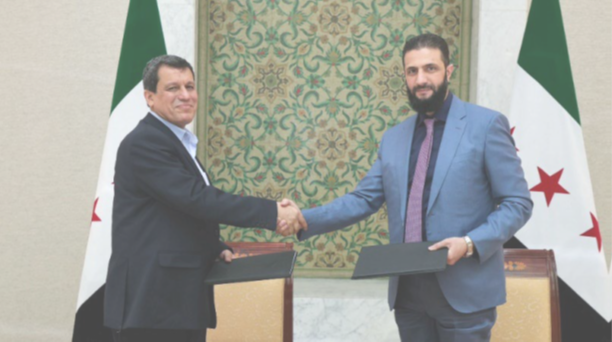Syrian civil war and the fall of the Assad regime
Current topics, April 2025.
The rebel offensive throughout Syria began on 27 November 2024 when the Military Operations Command, a coalition of Syrian opposition groups led by Hay’at Tahrir al-Sham (HTS), launched a large-scale offensive against Syrian government forces that culminated in the overthrow of the Bashar al-Assad regime.
From 29 November to 8 December, the rebel forces captured the cities of Aleppo, Hamas, and Homs. At the same time, other rebel groups seized Syrian government territory in the south and east.
The Assad regime fell when the rebel forces arrived in Damascus, and on December 8 2024, Assad was reported to have fled the capital. His regime collapsed, and more than 60 years of Ba’ath rule came to an end. Assad and his family fled to Moscow.
The Syrian Salvation Government (SSG) established an interim government, with Mohammed al-Bashir as prime minister. The head of the SSG, Ahmed al-Sharaa, became the de facto leader of Syria. In December 2024, SSG was replaced by the Syrian transitional government.
Immediately after the fall of the Assad regime, Israel announced that it would send troops to support the maintenance of the buffer zone controlled by the United Nations Disengagement Observer Force (UNDOF). Furthermore, Israel took control of Mount Hermon. The Syrian side of Mount Hermon is one of three Israeli-defined “safe zones” in Syrian territory. The mountain is strategically important because it is possible to survey both the Southern Syrian plain and the Bekaa Valley in Lebanon.
Iran announced its “strong” support for the Assad regime. The rebel offensive in Syria began after Assad’s key ally Hezbollah was weakened by the war in Lebanon and after Israel intensified its attacks against Iranian-backed groups in Syria. Hezbollah has previously supported Assad with thousands of soldiers. As the rebels approached Damascus, Iran evacuated its military and diplomatic personnel from Syria.
Russia withdrew from two of its bases that it had gained access to in a 2019 peacekeeping agreement with the Syrian government. Russia evacuated its military base in Homs, leaving it with only the Khmeimin air base and the Tartus naval base.
The United States, Britain, and France quickly reopened relations with the Syrian regime and lifted sanctions imposed on the previous regime.
The rebel groups joined the forces of the new regime in January 2025 at the Revolution Victory conference, where the new government also appointed al-Sharaa as president for a transitional period. The armed groups that fought against the Assad regime were disbanded, and about 80,000 fighters were incorporated into the new Syrian army. President al-Sharaa announced the dissolution of Assad’s Ba’ath party. Later, the Kurdish Syrian Democratic Forces (SDF) also agreed to integrate into state institutions. The Suwayda Military Council, which represents rebel groups in southern Syria, agreed to do the same. This meant the unification of all Syrian revolutionary factions in the transitional government.
Based on a draft by the Syrian Constitutional Law Committee, interim President al-Sharaa signed an interim constitution for five years in March 2025. It is based on Islamic jurisprudence and defines the separation of powers, including an independent judiciary. The president promised to protect the rights of all ethnic and religious groups in Syria.
About half a million people lost their lives, and 12 million were forced to leave their homes because of the Syrian Civil War, which started in 2011. According to the UN, at the beginning of 2023, 15.3 million people needed humanitarian assistance in Syria. The situation was exacerbated by a massive earthquake in February 2023, and Syria was also hit by the Covid-19 pandemic and a cholera epidemic. 6 million Syrians have fled abroad, mainly to Lebanon, Jordan, and Turkey.
Syria’s transitional government has also faced opposition from Assad’s loyalists and former allies.
The fall of the Syrian regime has had geopolitical consequences as the struggle for influence over Syria began between external actors. The interests of Saudi Arabia, Egypt, the United Arab Emirates, Turkey, and Qatar are partially at odds. Egypt and the Gulf countries are trying to prevent the rise of Islamist groups such as the Muslim Brotherhood, but Turkey and Qatar support them.
Israel seeks to maintain its security by force and promotes the fragmentation of Syria to prevent the emergence of a new hostile force. The United States supports Kurdish-led groups and counterforces from groups that it defines as terrorists.
Iran lost an important ally with the fall of Assad. The fall of Assad was also detrimental to Russia’s foreign policy, as it makes it more difficult to support Russia’s allies in Africa (Mali, Burkina Faso and Niger).
Sources: CNN, Wall Street Journal, Al-Jazeera, CBS News, Al-Monitor, The New Arab, The New York Times, Reuters, Bloomberg, BBC News, Sky News, AP, AFP, Institute for Study of War (ISW), Critical Threats (CT), International Crisis Group, CrisisWatch (ICG), https://en.wikipedia.org/wiki/Syrian_civil_war; https://en.wikipedia.org/wiki/Syrian_transitional_government

Final phase of the Syrian civil war 27 November – 8 December 2024. Source: Syrian Civil War, Wikimedia Commons.

Syrian President al-Sharaa (right) and the commander of the Kurdish Syrian Democratic Forces (SDF) Mazloum Abdi (left) agreed to integrate the SDF into the Syrian interim government. Sources: Presidency of the Syrian Arab Republic 10.3.2025, Wikimedia Commons.
